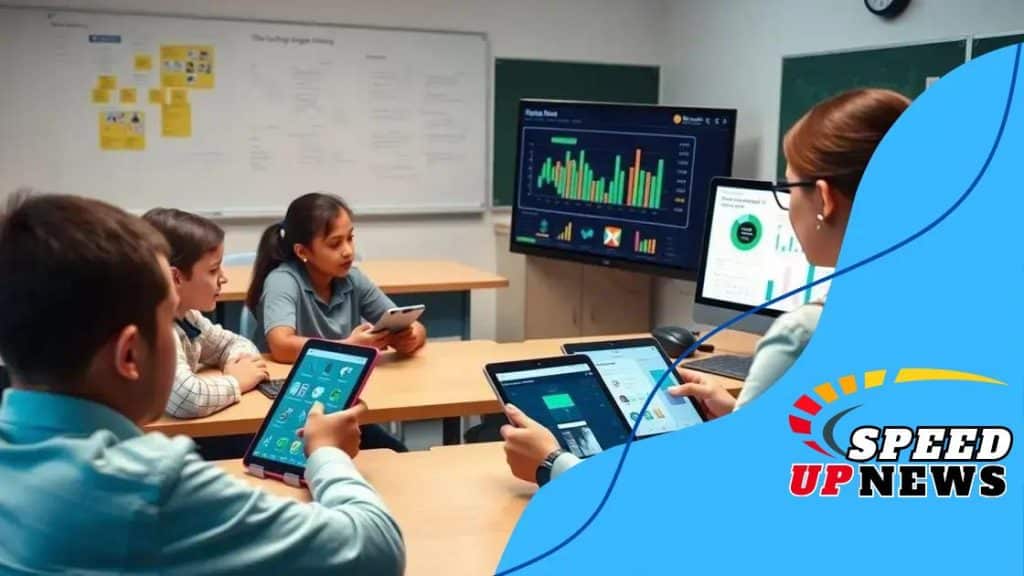AI-powered student engagement tracking systems transform classrooms

AI-powered student engagement tracking systems use advanced technology to monitor student participation, offering personalized insights that enhance educational experiences and improve learning outcomes.
AI-powered student engagement tracking systems are reshaping how we perceive education today. Imagine a classroom where teachers seamlessly connect with each student, adapting to their unique learning needs. Curious about how this technology can change the game for educators and learners alike? Let’s dive in.
Understanding AI-powered student engagement tracking systems
Understanding AI-powered student engagement tracking systems is crucial for enhancing educational experiences. These systems use advanced technology to monitor and analyze student interactions and involvement in the classroom. By leveraging real-time data, educators can better understand their students’ needs and tailor their teaching methods accordingly.
Through the application of artificial intelligence, these tracking systems provide valuable insights into how students engage with learning materials. Teachers can gain a deeper understanding of which topics capture students’ interests and which areas may require more attention.
Key Features of Engagement Tracking Systems
AI-powered systems come with a variety of features designed to improve student engagement. Some essential characteristics include:
- Real-time monitoring: Track student interactions as they happen, allowing for immediate feedback and adjustments.
- Data analytics: Analyze patterns in student engagement to identify strengths and areas for improvement.
- Adaptive learning: Customize educational materials to suit individual learning styles and preferences.
- Personalized feedback: Provide students with tailored recommendations to enhance their learning experience.
Another aspect of AI-powered engagement tracking is its ability to foster a more inclusive learning environment. By recognizing diverse learning needs, teachers can create strategies that engage all students effectively. This approach can be instrumental in ensuring that no student is left behind.
As we delve deeper into the capabilities of AI technologies, it’s clear that they play a significant role in shaping future educational practices. With tools that can gauge student participation and interest, teachers can make informed decisions about instructional strategies.
Investing in these innovative systems not only enhances the learning environment but also prepares students for a technology-driven world. AI-powered student engagement tracking systems represent a significant leap forward in educational technology, promising a more engaging and effective learning experience for all.
Key benefits for educators and students
AI-powered student engagement tracking systems offer numerous benefits for both educators and students. Understanding these advantages can help schools adopt these technologies more effectively.
Benefits for Educators
With these systems, teachers can see real-time data about student participation. This means they can quickly identify who is struggling and who is excelling, allowing for timely interventions. Additionally, analytics help educators refine their teaching strategies based on what truly engages their students.
- Improved instructional strategies: Data-driven insights allow teachers to adjust lesson plans flexibly.
- Enhanced communication: Data can open channels for discussions between teachers, students, and parents.
- Time savings: Automated reporting reduces the time spent on paperwork.
- Targeted support: Educators can tailor assistance to students’ specific needs.
Furthermore, these systems can foster collaboration amongst teachers. By sharing insights and strategies that work, educators can cultivate a more supportive learning environment.
Benefits for Students
Students, too, experience significant benefits from AI-powered tracking systems. One major advantage is personalized learning, where each student receives support tailored to their unique needs. With immediate feedback, students can understand their strengths and areas requiring improvement.
This engagement encourages students to take ownership of their learning process. They develop self-awareness and a better understanding of their educational paths, leading to greater motivation. Moreover, AI-driven insights help students manage their time and focus on specific topics more effectively.
As both educators and students embrace the capabilities of AI technologies, the overall learning experience is greatly enhanced. This modern approach to education ensures that everyone benefits in a variety of ways, leading to a more engaging and impactful learning journey.
How data analytics improves student involvement

Data analytics plays a vital role in enhancing student involvement in the classroom. By analyzing data collected through student engagement tracking systems, educators gain insights into how their students participate in learning activities.
One key aspect is understanding patterns of engagement. Educators can see which activities keep students interested and which do not. This information helps teachers adjust their methods to be more effective. For example, if data shows that students are more active during group discussions than lectures, teachers can increase interactive sessions.
Real-Time Feedback
Another advantage of data analytics is the ability to provide real-time feedback. Students can receive immediate insights into their performance, motivating them to improve. This timely information encourages learners to take ownership of their education. When students see their progress, they are more likely to stay engaged.
- Personalized learning: Tailored feedback allows students to focus on specific areas for growth.
- Increased motivation: Students are more engaged when they understand how their efforts impact their learning.
- Enhanced communication: Teachers can share data-driven insights with students, promoting transparency.
- Goal setting: With clear metrics, students can set achievable goals, enhancing their sense of purpose.
Data analytics also helps identify students who might need additional support. When patterns of disengagement appear, educators can intervene early. This proactive approach addresses issues before they escalate, ensuring that all students stay involved.
Furthermore, analyzing data can contribute to a collaborative learning environment. By discussing trends with colleagues, teachers can share successful strategies and adapt to meet their students’ needs better. Leveraging analytics effectively turns data into a powerful tool for fostering student engagement.
Implementing AI tracking in your school
Implementing AI tracking systems in your school can transform the educational experience for both students and teachers. This process involves a series of strategic steps to ensure successful adoption and integration.
First, it is essential to assess the needs of your school. Understanding the areas where engagement tracking can provide the most benefit will guide your implementation strategy. Communicating with educators and students about their experiences can help identify specific challenges you may want to address.
Choosing the Right System
Next, selecting the right AI tracking system is crucial. Not all systems are created equal, and schools should consider features that align with their unique requirements. Some important factors to consider include:
- User-friendliness: The system should be easy for both teachers and students to navigate.
- Compatibility: Ensure the AI system can integrate smoothly with existing educational technology.
- Analytics capabilities: Look for features that provide detailed data and reporting functions.
- Support and training: Choose a provider that offers strong support and training for staff to use the system effectively.
Once you have selected a system, the next step is to provide training for teachers and staff. Offering thorough training ensures that everyone understands how to use the system effectively. This training can range from basic navigation to advanced data analysis techniques, empowering educators to utilize the information gathered to enhance student engagement.
Moreover, involving students in the process can lead to greater acceptance of the technology. Providing them with hands-on demonstrations will help them understand the value of their engagement data. They can learn how to track their progress and use insights to improve their learning strategies.
Monitoring and Adjusting
After implementation, it is essential to monitor the effectiveness of the AI tracking system. Collect feedback from both teachers and students to identify any difficulties they might face. Regularly reviewing the data will allow schools to make adjustments as needed, ensuring that the system continues to evolve with the school’s needs.
By embracing AI tracking, schools can foster an environment of continuous improvement and student engagement. This technology not only provides insights into student behaviors but also enhances the overall learning experience.
Future trends in student engagement technology
The future of student engagement technology holds exciting possibilities as advancements in technology continue to reshape education. By staying informed about upcoming trends, schools can enhance learning experiences for students and educators alike.
One major trend is the increasing use of virtual and augmented reality in classrooms. These technologies offer immersive experiences that can transport students to different environments, making learning more engaging and interactive. By experiencing historical events or exploring scientific concepts firsthand, students can better retain information and connect with the material.
Artificial Intelligence Advancements
Moreover, the role of artificial intelligence in education will continue to expand. AI can analyze vast amounts of data to provide personalized learning experiences for students. Systems that adapt to individual learning styles can help each student succeed. By understanding when a student struggles, AI can suggest targeted resources and interventions, making education more effective.
- Enhanced analytics: Schools will be able to gather more metrics on student participation and performance.
- Predictive modeling: AI can forecast which students may need additional support based on engagement patterns.
- Chatbots: These can provide students with instant answers to questions, aiding their learning process.
- Gamification: Incorporating game-like elements into learning can further increase student motivation.
Furthermore, collaborative platforms will likely play a key role in the future of education. Tools that promote teamwork and communication foster an environment where students can engage more fully. These platforms can enhance partner learning, allowing students to collaborate regardless of location.
Another trend is the focus on mental health and social-emotional learning (SEL). Technologies designed to support student well-being will gain prominence as schools recognize the importance of mental health in the learning process. Apps that promote mindfulness, stress management, and emotional awareness can significantly benefit student engagement.
As schools embrace these trends, the landscape of student engagement technology will continue to evolve, offering innovative ways to inspire and motivate learners.
Conclusion: The landscape of education is rapidly changing with the integration of AI-powered student engagement tracking systems. As we explore future trends in technology, it is clear that these advancements will benefit both educators and students. By adopting tools like virtual reality, artificial intelligence, and collaborative platforms, schools can create enriched learning environments. The focus on mental health and emotional well-being further ensures that students are supported on all fronts. Embracing these technologies will lead to a more engaging and effective educational experience, preparing students for a successful future.
FAQ – Common Questions about AI-Powered Student Engagement Tracking Systems
What are AI-powered student engagement tracking systems?
These systems use artificial intelligence to monitor and analyze students’ participation and engagement in classroom activities.
How can these systems benefit educators?
They provide real-time insights into student performance, allowing educators to tailor their teaching methods and better support individual learning needs.
What role does data analytics play in improving student involvement?
Data analytics helps identify patterns in student engagement, enabling timely interventions and more effective instructional strategies.
What are some future trends in student engagement technology?
Future trends include the use of virtual and augmented reality for immersive learning, advancements in AI for personalized education, and tools that support students’ mental health.





